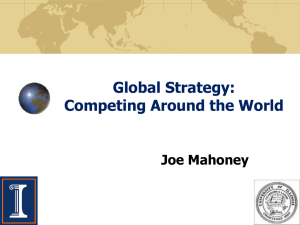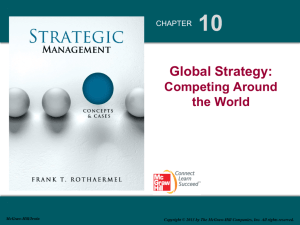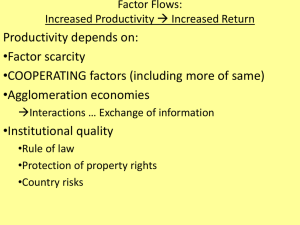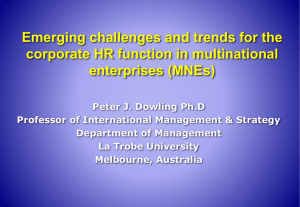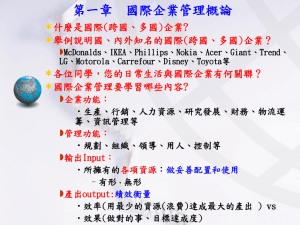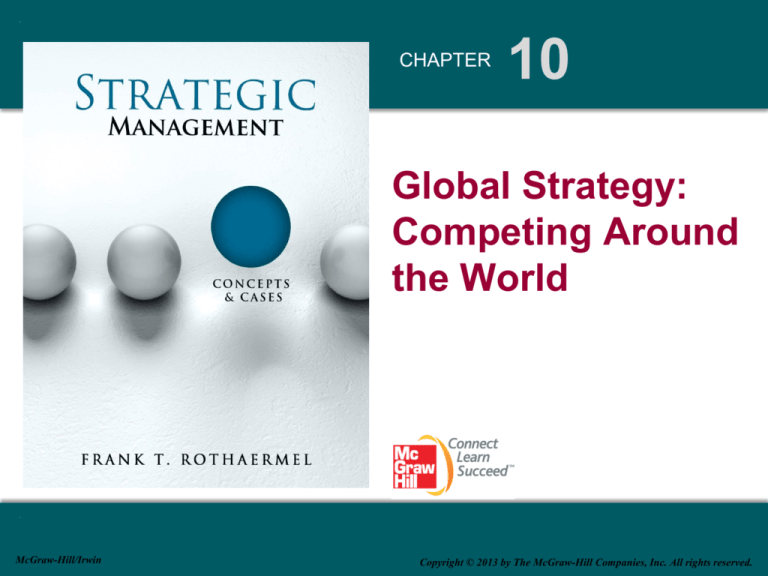
CHAPTER
10
Global Strategy:
Competing Around
the World
McGraw-Hill/Irwin
Copyright © 2013 by The McGraw-Hill Companies, Inc. All rights reserved.
Part 2 Strategy Formulation
2–2
2–2
LO 10-1
Define globalization, multinational enterprise (MNE),
foreign direct investment (FDI), and global strategy.
LO 10-2
Explain why companies compete abroad and evaluate
advantages and disadvantages.
LO 10-3
Explain which countries MNEs target for FDI, and how they
enter foreign markets.
LO 10-4
Describe the characteristics of and critically evaluate the
four different strategies MNEs can pursue when competing
globally.
LO 10-5
Explain why certain industries are more competitive in
specific nations than in others.
LO 10-6
Evaluate the relationship between location in a regional
cluster and firm-level competitive advantage.
Chapter Case 10
Hollywood Goes Global
• Hollywood movie: The quintessential American product
However, non-US sales increased: 50% in 2000,
and 70% in 2010
Altered global strategic focus
Movies that fit the global market by adapting foreign scripts, hiring
international actors/actresses…etc.
• Treat emerging markets as focal targets
Not just filmmaking industries, but also the electronics industry
(example: Korea, China), and auto industry (example: India)
Key questions: How can a company compete effectively in a
global market place?
EXHIBIT 10.1
Lifetime Revenues - Blockbuster Movies
What Is Globalization?
•
Globalization is a process of closer integration and
exchange between different countries and peoples
worldwide.
•
Made possible by:
Falling trade and investment barriers
Advanced telecommunications
Reduced transportation costs
Importance of MNEs and FDIs
What Is Globalization?
• Multinational Enterprise (MNE)
Deploys resources and capabilities in the
procurement, production, and distribution in
at least two countries
Less than 1% of firms, BUT employ 19% of U.S. workforce
– 74% of private sector R&D spending
• Foreign Direct Investment (FDI)
Investments in value chain activities abroad
• Global Strategy
To sustain a competitive advantage
Competing against foreign and domestic companies
around the world
Why Global?
• Gain access to a larger market
Capitalize on market potential, such as China, India,
and emerging economies
• Gain access to low-cost input factors
Labor, natural resources, technology, logistics
• Managing corporate risk
• Leverage core competencies
• Develop new competencies
Location economies
Unique locational advantages
STRATEGY HIGHLIGHT 10.1
Stages of Globalization
• Globalization 1.0: 1900–1941
Only sales and distribution took place overseas
• Globalization 2.0: 1945–2000
Duplicating business functions overseas
• Globalization 3.0: 21st century
MNEs become global collaboration networks
(see Exhibit 10.2)
1–9
EXHIBIT 10.2
Globalization 3.0 - Collaboration Networks
EXHIBIT 10.3
International Sales as % of Total
Data from 2010
STRATEGY HIGHLIGHT 10.2
Does GM’s Future Reside
in China?
• Market opportunity in China
1.4 billion population, only 1 in 100 people owns a vehicle
• GM entered China in 1997
Joint venture with Shanghai Automotive Industrial Corp
China is 25% of GM’s revenues and GROWING fast
GM China factories are more productive than U.S. plants
• GM’s future relies on China and other emerging economies
$ 250 million on a state-of-the-art R&D center…in Shanghai
Future of GM likely decided in their international HQ…in Shanghai
1–12
Disadvantages of Expanding Internationally
• Liability of foreignness
Additional cost of doing business in an
unfamiliar cultural and economic environment
Cost of coordinating across geographic distance
Economic development may increase the cost of
doing business
Rising wages with improved living standards
Difficulty in protecting intellectual property
LO 10-1 Define globalization, multinational enterprise (MNE), foreign
direct investment (FDI), and global strategy.
LO 10-2 Explain why companies compete abroad and evaluate
advantages and disadvantages.
LO 10-3 Explain which countries MNEs target for FDI, and how
they enter foreign markets.
LO 10-4 Describe the characteristics of and critically evaluate the
four different strategies MNEs can pursue when
competing globally.
LO 10-5 Explain why certain industries are more competitive in specific
nations than in others.
LO 10-6 Evaluate the relationship between location in a regional cluster
and firm-level competitive advantage.
Global Expansion: Where
• How does an MNE decide where to go?
National institutions:
Well-established legal and ethical pillars as well as
well- functioning economic institutions such as
capital markets, banks, and infrastructures
National culture: "Programming of the mind"
Geert Hofstede’s Cultural Dimensions
1.
2.
3.
4.
5.
Power distance
Individualism
Masculinity/femininity
Uncertainty-avoidance
Long-term orientation
EXHIBIT 10.4
Corporate Tax Rates
Institutional Difference Matters
Global Expansion: How
• Exporting: producing goods in one country to sell
in another country
• Acquisition, strategic alliance are also popular
vehicles for entry into foreign markets
• MNEs sometime prefers greenfield operations
or wholly-owned subsidiaries
Greenfield is building new factories/offices from scratch
Physically and organizationally building from the "ground up."
EXHIBIT 10.5
Modes of Foreign Market Entry
Market Entry along the
Investment and Control Continuum
Strategy around the World:
Cost Reduction vs. Local Responsiveness
• Local responsiveness:
Tailor product and service offerings to fit local
consumer preferences and host-country requirements
Higher cost
Example: McDonald’s uses mutton in India
•Cost reduction:
MNEs enter global marketplace with the intention to
reduce operation cost
Example: Toyota Prius
EXHIBIT 10.6
The Integration-Responsiveness Framework
Four Global Strategies
• International strategy
Leveraging home-based core competencies
Selling the same products or services in both domestic
and foreign markets
Example: Selling Starbucks coffee internationally
• Localization (product differentiation) strategy
Maximize local responsiveness via a
multi-domestic strategy
Consumers will perceive them to be domestic
companies
Example: Nestlé’s customized product offerings
Four Global Strategies
• Global standardization (cost leadership) strategy
Economies of scale and location economies
Pursuing a global division of labor based on best-of-class
capabilities reside at the lowest cost
Example: Lenovo’s R&D in Beijing, Shanghai, and Raleigh;
production center in Mexico, India, and China
• Transnational strategy
Combination of localization strategy (high
responsiveness) with global standardization strategy
(lowest cost position attainable)
Example: German multimedia conglomerate Bertelsmann
Characteristics, Benefits, and Risks
of Four Types of Global Strategy
EXHIBIT 10.7
Characteristics
• Often the first step in
internationalizing.
• Used by MNEs with relatively large
domestic markets (e.g., MNEs from
U.S., Germany, Japan).
International
Strategy
Localization
(Multidomestic)
Strategy
Benefits
• Leveraging core
competence.
• Economies of scale.
• Low-cost implementation
through:
Risk
• No or limited local
responsiveness.
• Highly affected
by exchange rate
fluctuations.
• Well-suited for high-end products
• Exporting or licensing
• IP embedded in product
(such as machine tools) and luxury
goods that can be shipped across
the globe.
• Products and services tend to have
strong brands.
• Main competitive strategy tends to
be differentiation since exporting,
licensing, and franchising add
additional costs.
• Used by MNEs to compete in
host countries with large and/or
lucrative but idiosyncratic domestic
(for products)
• Franchising (for services)
• Licensing (for trademarks)
or service could be
expropriated.
• Highest-possible local
responsiveness.
• Reduced exchange-rate
• Duplication of key
business functions
in multiple countries
markets (e.g., Germany, Japan,
exposure.
leads to high cost of
Saudi Arabia).
implementation.
• Often used in consumer products
and food industries.
• Main competitive strategy is
differentiation.
• MNE wants to be perceived as local
company.
• Little or no economies of
scale.
• Little or no learning across
different regions.
• Higher risk of IP
Expropriation.
EXHIBIT 10.7
Characteristics, Benefits, and Risks
of Four Types of Global Strategy
Characteristics
Benefits
Risk
Global-
• Used by MNEs that are offering
• Location economies:
• No local responsiveness.
Standardization
standardized products and services
global division of labor
• Little or no product
Strategy
(e.g., computer hardware or
based on wherever best-of-
differentiation.
business process outsourcing).
class capabilities
• Some exchange-rate
• Main competitive strategy is price.
reside at lowest cost.
exposure.
• Economies of scale.
• “Race to the bottom” as
wages increase.
• Some risk of IP
expropriation.
Transnational
• Used by MNEs that pursue an
• Attempts to combine
• Global matrix structure
(Glocalization)
integration strategy at the business
benefits of localization and
is costly and difficult to
Strategy
level by simultaneously focusing on
standardization strategies
implement, leading to high
product differentiation and low cost.
simultaneously by creating
failure rate.
• Mantra: Think globally, act locally.
a global matrix structure.
• Some exchange-rate
• Economies of scale,
exposure.
location, and learning.
• Higher risk of IP expropriation.
STRATEGY HIGHLIGHT 10.3
Wal-mart Retreats
from Germany
• Wal-mart entered Germany
Acquisition of 21 stores and 74 hypermarkets
• Wal-mart duplicated its U.S. policies and applied them in Germany
Employees refused to accept those policies
• Wal-mart faced significant cultural differences
• Wal-mart could not develop efficient economies of scale and distribution
centers to drive cost down
• The result is a defeated Wal-mart that sold its stores to Metro,
Wal-mart’s key rival in Germany
• ALDI, another of Wal-mart’s competitors in Germany, is now expanding
aggressively in the U.S.
1–26
LO 10-1 Define globalization, multinational enterprise (MNE), foreign
direct investment (FDI), and global strategy.
LO 10-2 Explain why companies compete abroad and evaluate
advantages and disadvantages.
LO 10-3 Explain which countries MNEs target for FDI, and how they
enter foreign markets.
LO 10-4 Describe the characteristics of and critically evaluate the
four different strategies MNEs can pursue when
competing globally.
LO 10-5 Explain why certain industries are more competitive in
specific nations than in others.
LO 10-6 Evaluate the relationship between location in a regional
cluster and firm-level competitive advantage.
National Competitive Advantage
• Death-of-distance hypothesis
Geographic location alone should not lead to firm-level
competitive advantage because firms are now more
able to source inputs globally (ex: capital, commodities,
etc.) Labor markets also have become more global.
Computer manufacturers – China & Taiwan
Consumer electronics – Japan & South Korea
Mining companies – Australia
• Why are certain industries in some countries more
competitive than in others?
Answer: National Competitive Advantage
EXHIBIT 10.8
Porter’s Diamond Model of National
Competitive Advantage
Porter American
Future Video
National Competitive Advantage Framework
• Factor conditions
A nation’s endowments in terms of national, human, and other
resources as well as supportive infrastructure and institutions.
• Demand conditions
Specific characteristics of demand in a firm’s domestic market
• Competitive intensity
Highly competitive environments tend to stimulate firms to
outperform others (e.g., German car industry)
• Related and supporting industry
Leadership in related and supporting industries can also foster
world-class competitors in downstream industry
Complementarity
Regional Clusters
• Regional cluster
A group of interconnected companies and
institutions in a specific industry, located
near each other geographically and linked
by common characteristics
Knowledge spillover
Positive externalities that are
regionally constrained
Exchange of ideas among firms
in a cluster
EXHIBIT 10.9
Mapping a Regional Cluster: Research Triangle
Geographical Distribution of Clusters
Boise
Boston
Wisconsin / Iowa / Illinois
Minneapolis
Information Tech Agricultural Equipment
Mutual Funds
West Michigan
Western Massachusetts
Cardio-vascular Office and Institutional
Farm Machinery
Medical Devices
Polymers
Omaha
Equipment
Mgmt. Consulting
Furniture
Seattle
Rochester
Telemarketing
and Services
Biotechnology
Aircraft Equipment and Design
Imaging Equipment
Hotel Reservations
Software and
Michigan
Software
Credit Card Processing
Networking
Clocks
Warsaw, Indiana
Coffee Retailers
Venture Capital
Detroit
Orthopedic Devices
Auto Equipment
Hartford
and Parts
Insurance
Oregon
Electrical Measuring
Providence
Equipment
Jewelry
Woodworking Equipment
Marine Equipment
Logging / Lumber Supplies
New York City
Financial Services
Silicon Valley
Advertising
Microelectronics
Publishing
Biotechnology
Multimedia
Venture Capital
Pennsylvania / New Jersey
Pharmaceuticals
Las Vegas
Pittsburgh
Amusement /
Advanced Materials
Casinos
Energy
Small Airlines
North Carolina
Household Furniture
Los Angeles Area
Synthetic Fibers
Defense Aerospace
Hosiery
Entertainment
Wichita
Cleveland / Louisville
Light Aircraft
San Diego
Paints & Coatings
Farm Equipment
Baton Rouge /
Golf Equipment
New Orleans
Biotech/Pharma
Dalton, Georgia
Dallas
Specialty Foods
Carpets
Real Estate
Southeast Texas /
Development
Nashville / Louisville
Louisiana
Colorado
Hospital Management
South Florida
Chemicals
Computer Integrated Systems / Programming
Health Technology
Engineering Services
Computers
Mining / Oil and Gas Exploration
Source: Adapted from Professor Michael E. Porter, Harvard Business School
Take-Away Concepts
LO 10-1 Define globalization, multinational enterprise (MNE), foreign direct investment (FDI),
and global strategy.
Globalization involves closer integration and exchange between different
countries and peoples worldwide, made by factors such as falling trade and
investment barriers, advances in telecommunications, and reductions in
transportation costs.
A multinational enterprise (MNE) deploys resources and capabilities to procure,
produce, and distribute goods and services in at least two countries.
Foreign direct investment (FDI) denotes a firm’s investments in value chain
activities abroad.
LO 10-2 Explain why companies compete abroad and evaluate advantages and
disadvantages.
Firms compete internationally to gain access to a larger market, gain access to
low-cost input factors, and develop new competencies.
To compete successfully abroad, firms must overcome the liability of foreignness.
Take-Away Concepts
LO 10-2 Explain why companies compete abroad and evaluate advantages and
disadvantages. (cont’)
As local wages and costs of living increase, a low-cost location
advantage evaporates. On the upside, this can turn producers into
consumers.
Constant pressures to reduce cost lead to a “race-to-the-bottom” where
MNEs chase the lowest cost locations.
LO 10-3 Explain which countries MNEs target for FDI, and how they enter foreign
markets.
When an MNE has to decide between countries in which to invest, two
additional country-level factors come into play: national institutions and
national culture.
Managers have the following strategy vehicles for entering foreign
markets (on a continuum from low to high investment needs and
control): exporting, strategic alliances (licensing for products, franchising
for services), joint venture, and subsidiary (acquisition or greenfield).
Take-Away Concepts
LO 10-4 Describe the characteristics of and critically evaluate the four different
strategies that MNEs can pursue when competing globally.
To navigate between the competing pressures of cost reductions and
local responsiveness, MNEs have four strategies: international,
localization, global-standardization, and transnational.
An international strategy leverages home-based core competencies into
foreign markets, primarily through exports. It is useful when the MNEs
face low pressures for both local responsiveness and cost reductions.
A localization strategy attempts to maximize local responsiveness in the
face of low pressure for cost reductions. It is costly and inefficient
because it requires the duplication of key business functions in multiple
countries.
A global standardization strategy seeks to reap economies of scale and
location by pursuing a global division of labor based on wherever bestof-class capabilities reside at the lowest cost. It involves little or no local
responsiveness.
Take-Away Concepts
LO 10-4 Describe the characteristics of and critically evaluate the four different
strategies that MNEs can pursue when competing globally. (Cont’)
A transnational strategy attempts to combine the high local
responsiveness of a localization strategy with the lowest cost position
attainable from a global-standardization strategy. It also aims to benefit
from global learning. Although appealing, it is difficult to implement due
to the organizational complexities involved.
Exhibit 10.7 summarizes the characteristics, benefits, and risks of the
four global competition strategies.
LO 10-5
Explain why certain industries are more competitive in specific nations
than in others.
National competitive advantage, or world leadership in specific
industries, is created rather than inherited.
Four interrelated factors explain national competitive advantage: (1)
factor conditions, (2) demand conditions, (3) competitive intensity in a
focal industry, and (4) related and supporting industries/complementors.
Take-Away Concepts
LO 10-6 Evaluate the relationship between location in a regional cluster and
firm-level competitive advantage.
Even in a globalized world, the basis for competitive advantage is often
local.
Strong empirical evidence suggests that being located in a regional
cluster can have a positive effect on firm-level competitive advantage,
both domestically and globally.

